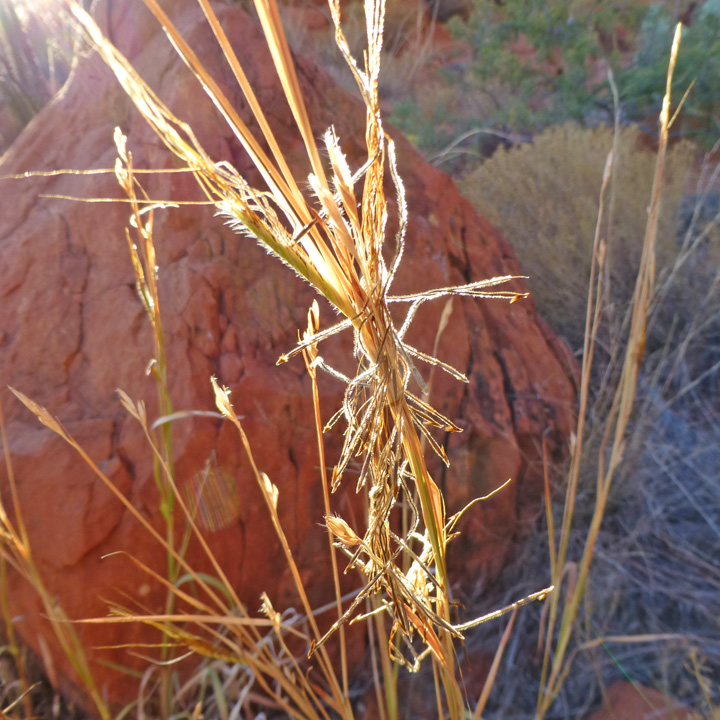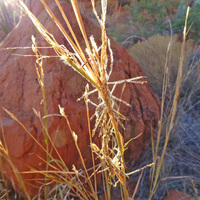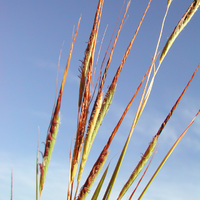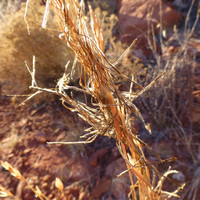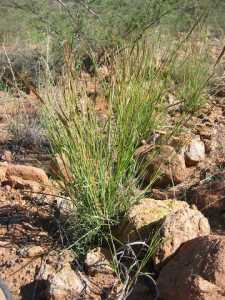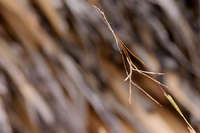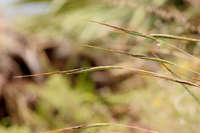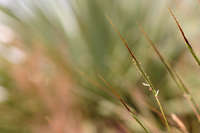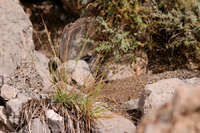Plants perennial. Culms 20-150 cm, erect. Sheaths smooth, reddish; ligules 0.5-0.8 mm, cilia 0.2-0.5 mm; blades 10-15 cm long, 2-7 mm wide, flat or folded, glabrous or pubescent. Rames 3-7 cm, secund, with 12-22, brown to reddish-brown, sessile-pedicellate spikelet pairs. Homogamous spikelets 6-10 mm. Heterogamous spikelets: sessile spikelets 5-10 mm, brown, awned; calluses 1.8-2 mm, strigose; awns 6-10 cm; pedicellate spikelets 6-10 mm, unawned; glumes ovate-lanceolate, glabrous or with papillose-based hairs distally, without glandular pits, greenish to purplish-brown, becoming stramineous when dry. 2n = 40, 50, 60.
Heteropogon contortus is a valuable forage grass if continuously grazed so as to prevent the calluses from developing. It is also considered a weed, being able to establish itself in newly disturbed and poor soils.
Perennials, Terrestrial, not aquatic, Stems nodes swollen or brittle, Stems erect or ascending, Stems caespitose, tufted, or clustered, Stems terete, round in cross section, or polygonal, Plants aromatic or malodorous, Stem internodes hollow, Stems with inflorescence less than 1 m tall, Stems, culms, or scapes exceeding basal leaves, Leaves mostly cauline, Leaves conspicuously 2-ranked, distichous, Leaves sheathing at base, Leaf sheath mostly open, or loose, Leaf sheath smooth, glabrous, Leaf sheath or blade keeled, Leaf sheath and blade differentiated, Leaf blades linear, Leaf blades 2-10 mm wide, Leaf blades mostly flat, Leaf blades mostly glabrous, Ligule present, Ligule a fringed, ciliate, or lobed membrane, Ligule a fringe of hairs, Inflorescence terminal, Inflorescence a dense slender spike-like panicle or raceme, branches contracted, Inflorescence solitary, with 1 spike, fascicle, glomerule, head, or cluster per stem or culm, Inflorescence single raceme, fascicle or spike, Inflorescence branches 1-sided, Flowers bisexual, Flowers unisexual, Spikelets pedicellate, Spikelets sessile or subsessile, Spikelets dorsally compressed or terete, Inflorescence or spikelets partially hidden in leaf sheaths, subtended by spatheole, Spikelet less than 3 mm wide, Spikelets with 2 florets, Spikelets paired at rachis nodes, Spikelets in paired units, 1 sessile, 1 pedicellate, Pedicellate spikelet rudimentary or absent, usually sterile, Spikelets bisexual, Spikelets unis exual, Spikelets disarticulating below the glumes, Spikelets disarticulating beneath or between the florets, Spikelets conspicuously hairy , Rachilla or pedicel glabrous, Glumes present, empty bracts, Glumes 2 clearly present, Glumes equal or subequal, Glumes equal to or longer than adjacent lemma, Glume surface hairy, villous or pilose, Glumes 8-15 nerved, Lemmas thin, chartaceous, hyaline, cartilaginous, or membranous, Lemma 3 nerved, Lemma apex acute or acuminate, Lemma distinctly awned, more than 2-3 mm, Lemma with 1 awn, Lemma awn 2-4 cm long or longer, Lemma awned from tip, Lemma awn twisted, spirally coiled at base, like a corkscrew, Lemma awn once geniculate, bent once, Lemma margins thin, lying flat, Lemma straight, Callus or base of lemma evidently hairy, Callus hairs shorter than lemma, Stamens 3, Styles 2-fid, deeply 2-branched, Stigmas 2, Fruit - caryopsis, Caryopsis ellipsoid, longitudinally grooved, hilum long-linear.
Common Name: tanglehead
Duration: Perennial
Nativity: Native
Lifeform: Graminoid
General: Small, tufted perennial grass; culms erect, 20-150 cm tall, usually branching well above the base.
Vegetative: Sheaths smooth, reddish, compressed-keeled, mostly glabrous, with few long hairs at junction with blade; ligules <1 mm, truncate, membranaceous, brown, and fringed with white hairs; blades 10-15 cm long, 2-7 mm wide, folded or occasionally flat, glabrous
Inflorescence: Rames 3-7 cm long, with 12-22, brown to reddish-brown, sessile-pedicellate spikelet pairs. The lowest few pairs of spikelets homogamous, unawned, 6-10 mm. Distal spikelet pairs heterogamous, with long-awned sessile spikelets, 5-10 mm, brown, the awns 6-10 cm, calluses 2 mm, strigose; pedicellate spikelets of the heterogamous pairs unawned, 6-10 mm; glumes ovate-lanceolate, glabrous or with papillose-based hairs distally, greenish to purplish-brown, becoming stramineous when dry. Disarticulation in the rames, beneath the sessile spikelets of the heterogamous pairs, sometimes also below their pedicellate spikelets.
Ecology: Found in open, dry, rocky and sandy plains and slopes, from 1,000-5,500 ft (305-1676 m); flowers August to October, and occasionally in the springtime also.
Distribution: s CA, AZ. s NM, s TX; south to s through MEX to S America and much of the Old World.
Notes: A distinct perennial grass to 1.5 m, distinguished by the single-seeded spikelets with long, twisted, dark brown awns, which often fall entangled with the awns of other spikelets; also look for the large green-brown glumes subtending each spikelet which hug the inflorescence spike. A valuable forage grass.
Ethnobotany: Unknown
Etymology: Heteropogon is from Greek for differently or variously bearded, alluding to the difference between the awnless-homogamous spikelets and the awned-heterogamous spikelets; contortus means twisted, referring to the long, twisted awns.
Synonyms: Andropogon contortus
Editor: SBuckley 2010, FSCoburn 2014, AHazelton 2015


